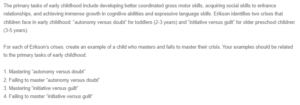Creating Examples of Erikson’s Crises of Early Childhood
Mastering “Autonomy versus Doubt”
A child who masters this conflict has a heightened sense of self-control, self-sufficiency, and confidence (Ashford et al., 2018). For example, Misha, a two-year-old and five-month-old girl, has been showing interest in the choice of clothes her mother dresses her in. She selects and confidently sticks to her choice of clothes, regardless of whether her mother has other options.
Failing to Master “Autonomy versus Doubt
Children who fail to master the autonomy vs. doubt conflict have increased feelings of self-doubt and frustration (Ashford et al., 2018). For example, Erick, a 3-year-old boy, has been brought up by a nanny. She strictly attends to him, including feeding and dressing him and ensuring he never gets hurt. When the nanny or parents are not around, he fears playing alone as he is unsure of which toy to play with. He also usually trips over the toys and hurts himself.
Mastering “Initiative versus Guilt”
Children who master the initiative versus guilt conflict feel accomplished and have a better sense of purpose. For example, Donald, a 4-year-old boy, curiously watches his father work in his garage. His father usually shows him how to use the tools to fix a car. His father has been taking Donald’s toys apart, such as the wheels, and letting him pretend it is his car that has broken down. Although he struggles, he manages to put some parts together, and they always praise him when his toy car works.
Failing to Master “Initiative versus Guilt”
Pre-school-aged children who fail to master the “Initiative Versus Guilt” usually develop a sense of guilt and fear of new things. For example, Maria, a 5-year-old African American girl, has been brought up by her mother alongside her two elder brothers. Her mother is usually critical and mostly scolds her for minor mistakes. The mother and her brothers scold and make fun of her whenever she plays with her White neighbors. She stays indoors and has no White friends for fear of embarrassing her family.
References
Ashford, J. b., LeCroy, C. w., & Williams, L. R. (2018). Human behavior in the Social Environment: A multidimensional perspective. In Encyclopedia of Quality of Life and Well-Being Research (6th ed.). Cengage Learning.
ORDER A PLAGIARISM-FREE PAPER HERE
We’ll write everything from scratch
Question
The primary tasks of early childhood include developing better coordinated gross motor skills, acquiring social skills to enhance relationships, and achieving immense growth in cognitive abilities and expressive language skills. Erikson identifies two crises that children face in early childhood: “autonomy versus doubt” for toddlers (2-3 years) and “initiative versus guilt” for older preschool children (3-5 years).

Creating Examples of Erikson’s Crises of Early Childhood
For each of Erikson’s crises, create an example of a child who masters and fails to master their crisis. Your examples should be related to the primary tasks of early childhood.
1. Mastering “autonomy versus doubt”
2. Failing to master “autonomy versus doubt”
3. Mastering “initiative versus guilt”
4. Failing to master “initiative versus guilt”

